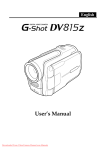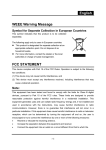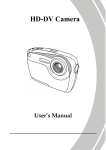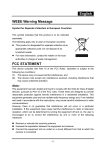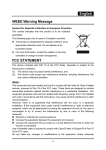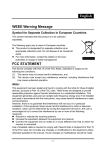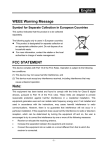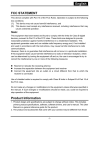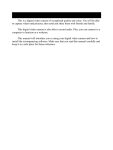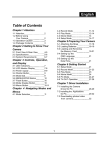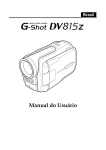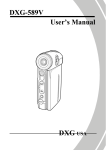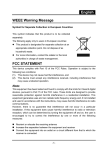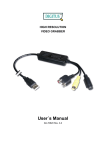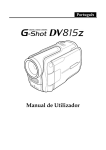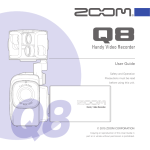Download User`s Manual
Transcript
English User’s Manual English WEEE Warning Message Symbol for Separate Collection in European Countries This symbol indicates that this product is to be collected separately. The following apply only to users in European countries: z This product is designated for separate collection at an appropriate collection point. Do not dispose of as household waste. z For more information, contact the retailer or the local authorities in charge of waste management. FCC STATEMENT This device complies with Part 15 of the FCC Rules. Operation is subject to the following two conditions: (1). This device may not cause harmful interference, and (2). This device must accept any interference received, including interference that may cause undesired operation. Note: This equipment has been tested and found to comply with the limits for Class B digital devices, pursuant to Part 15 of the FCC rules. These limits are designed to provide reasonable protection against harmful interference in a residential installation. This equipment generates uses and can radiate radio frequency energy and, if not installed and used in accordance with the 1 English instructions, may cause harmful interference to radio communications. However, there is no guarantee that interference will not occur in a particular installation. If this equipment does cause harmful interference to radio or television reception, which can be determined by turning the equipment off and on, the user is encouraged to try to correct the interference by one or more of the following measures: Reorient or relocate the receiving antenna Increase the separation between the equipment and receiver Connect the equipment into an outlet on a circuit different from that to which the receiver is connected Use of shielded cable is required to comply with Class B limits in Subpart B of Part 15 of the FCC rules. Do not make any changes or modifications to the equipment unless otherwise specified in the manual. If such changes or modifications should be made, you could be required to stop operation of the equipment. Product Information 1. Product design and specifications are subject to change without notice. This includes primary product specifications, software, software drivers, and user’s manual. This User Manual is a general reference guide for the product. 2. The product and accessories that come with your camera may be different from those described in this manual. This is due to the fact that different retailers often specify slightly different product inclusions and accessories to suit their market requirements, customer demographics, and geographical preferences. Products very often vary between retailers especially with accessories such as batteries, chargers, AC adapters, memory cards, cables, carrying cases/pouches, and language support. Occasionally a retailer will specify a unique product color, appearance, and internal memory capacity. Contact your dealer for precise product definition and included 2 English accessories. 3. The illustrations in this manual are for the purpose of explanation and may differ from the actual design of your camera. 4. The manufacturer assumes no liability for any errors or discrepancies in this user manual. 5. For driver updates, you can check the “Download” section of our website, www.geniusnet.com SAFETY INSTRUCTIONS Read and understand all Warnings and Cautions before using this product. Warnings If foreign objects or water have entered the camera, turn the power OFF and remove the battery. Continued use in this state might cause fire or electric shock. Consult the store of purchase. If the camera has fallen or its case has been damaged, turn the power OFF and remove the battery. Continued use in this state might cause fire or electric shock. Consult the store of purchase. Do not disassemble, change or repair the camera. This might cause fire or electric shock. For repair or internal inspection, ask retailer where you purchased it. Do not use the camera in areas near water. This might cause fire or electric shock. Take special care during rain, snow, on the beach, or near the shore. Do not place the camera on inclined or unstable surfaces. This might cause the camera to fall or tilt over, causing injury. Keep the batteries out of the reach of children. Swallowing batteries might cause poisoning. If the battery is accidentally swallowed, immediately consult a physician. 3 English Do not use the camera while you are walking, driving or riding a motorcycle. This might cause you to fall over or result in a traffic accident. Cautions Insert the batteries paying careful attention to the polarity (+ or –) of the terminals. Inserting the batteries with its polarities inverted might cause fire and injury, or damage to the surrounding areas due to the battery rupturing or leaking. Do not fire the flash close to anyone’s eyes. This might cause damage to the person’s eyesight. Do not subject the LCD monitor to impact. This might damage the glass on the screen or cause the internal fluid to leak. If the internal fluid enters your eyes or comes into contact with your body or clothes, rinse with fresh water. If the internal fluid has entered your eyes, consult a physician to receive treatment. A camera is a precision instrument. Do not drop it, strike it or use excessive force when handling the camera. This might cause damage to the camera. Do not use the camera in humid, steamy, smoky, or dusty places. This might cause fire or electric shock. Do not remove the battery immediately after long period of continuous use. The battery becomes hot during use. Touching a hot battery might cause burns. Do not wrap the camera or place it in cloth or blankets. This might cause heat to build up and deform the case, 4 English resulting in fire. Use the camera in a well-ventilated place. Do not leave the camera in places where the temperature may rise significantly, such as inside a car. This might adversely affect the case or the parts inside, resulting in fire. Before you move the camera, disconnect cords and cables. Failure to do this might damage cords and cables, resulting in fire and electric shock. Notes on Battery Usage When you use the battery, carefully read and strictly observe the Safety Instructions and the notes described below: Use only the specified battery. Avoid using the battery in extremely cold environments as low temperatures can shorten the battery life and reduce camera performance. When you are using the new rechargeable battery or rechargeable battery that has not been used for an extended period of time (the battery that passed the expiry date is an exception) might affect the number of images that can be captured. Therefore, to maximize its performance and lifetime, we recommend that you fully charge the battery and discharge it for at least one complete cycle before use. The battery may feel warm after long period of continuous use of the camera or the flash. This is normal and not a malfunction. The camera may feel warm after long period of continuous use. This is normal and not a malfunction. If the battery is not to be used for a long period of time, remove it from the camera to prevent leakage or corrosion. If the battery is not to be used for a long period of time, store it after no battery power left. If the battery is stored for a long time in a fully 5 English 6 charged state, its performance may be impaired. Always keep the battery terminals in a clean state. Risk of explosion if battery is replaced by an incorrect type. Dispose of used batteries according to the instructions. We recommend the battery should be charged 8 hours for first time use. English CONTENTS 1 Introducing the camera ........................... 12 1.1 1.2 1.3 2 System requirements ..............................................12 Unpacking the video camera.................................12 About the camera...................................................13 1.3.1 Front view ..................................................14 1.3.2 Top view.....................................................14 1.3.3 Back view ...................................................15 1.3.4 Right view ..................................................15 1.3.5 Bottom view...............................................16 1.3.6 LCD display ...............................................16 1.3.7 About the LEDs.........................................19 Getting started.......................................... 20 2.1 2.2 2.3 2.4 2.5 2.6 Inserting an SD card .............................................20 Inserting the batteries............................................21 Charging the battery..............................................22 Turning on for the first time .................................23 Changing modes ....................................................23 Before you start......................................................24 2.6.1 Setting the date and time.........................24 2.6.2 Setting the language .................................25 2.7 Shooting video........................................................26 2.7.1 To shoot a video clip: ...............................26 7 English 2.7.2 To playback the video clip ......................27 2.8 Taking still pictures................................................28 2.8.1 To take a still picture: ...............................28 2.8.2 To playback the picture: ..........................29 2.9 Voice recording ......................................................30 2.9.1 To make a voice recording: .....................30 2.9.2 To playback a voice file:...........................30 2.10 Playing music files.................................................31 2.10.1 To playback a music file: .........................31 2.11 Connecting to a computer .....................................32 2.12 Connecting to a TV................................................32 3 8 Using the camera...................................... 33 3.1 Video mode .............................................................33 3.1.1 Video mode icons .....................................33 3.1.2 Help information ......................................35 3.1.3 Quick access menu ...................................36 3.2 Photo mode.............................................................37 3.2.1 Photo mode icons......................................37 3.2.2 Setting the flash.........................................39 3.2.3 Using the macro function ........................39 3.2.4 Using the zoom function .........................40 3.2.5 Help information ......................................41 3.2.6 Quick access menu ...................................42 3.3 Voice mode .............................................................43 English 3.3.1 3.3.2 Voice mode icons ......................................43 Help information ......................................44 3.4 Music mode ............................................................45 3.4.1 Music mode icons .....................................45 3.4.2 Help information ......................................46 3.5 Playback mode .......................................................47 3.5.1 Displaying file information.....................47 3.5.2 Playback mode icons ................................48 3.5.3 Thumbnail mode.......................................49 3.6 3.7 USB mode...............................................................49 Storage device mode ..............................................49 4 Using the menus ....................................... 50 4.1 Video menu.............................................................50 4.1.1. Video Size...................................................50 4.1.2. Video Quality ............................................51 4.1.3. White balance ............................................52 4.1.4. Exposure adjustment (EV).......................53 4.1.5. Color effect.................................................54 4.1.6. Self timer ....................................................55 4.1.7. File format ..................................................56 4.1.8. Audio ..........................................................57 4.1.9. Continuous focus ......................................58 4.1.10. Stabilizer.....................................................59 4.2 Movie Playback menu ...........................................60 9 English 4.2.1 4.2.2 10 Delete all.....................................................60 Unlock all ...................................................61 4.3 Picture menu ..........................................................62 4.3.1 Size ..............................................................62 4.3.2 Image Quality ............................................63 4.3.3 White balance ............................................64 4.3.4 Exposure adjustment (EV).......................65 4.3.5 Color effect.................................................66 4.3.6 Self timer ....................................................67 4.3.7 Drive mode ................................................68 4.3.8 Date stamp .................................................69 4.3.9 Night mode ................................................70 4.4 Photo Playback menu............................................71 4.4.1 Delete all.....................................................71 4.4.2 Unlock all ...................................................72 4.4.3 Slide show ..................................................73 4.4.4 DPOF...........................................................74 4.5 Music menu............................................................76 4.5.1 Repeat .........................................................76 4.5.2 Delete all.....................................................77 4.5.3 Unlock all ...................................................78 4.6 System menu ..........................................................79 4.6.1 Date/time...................................................79 4.6.2 Beep .............................................................79 English 4.6.3 4.6.4 4.6.5 4.6.6 4.6.7 4.6.8 4.6.9 5 Format.........................................................80 Default ........................................................81 Memory ......................................................82 Language ....................................................82 TV ................................................................83 Power saving .............................................84 LCD brightness .........................................85 Installing software and drivers ............... 86 5.1 Drivers ....................................................................86 5.1.1 Mass Storage ..............................................86 5.2 5.3 5.4 Presto! Video Works 6............................................87 Presto! Mr. Photo 3 ...............................................87 XviD codec for PC .................................................88 Appendix............................................................ 92 Specifications ....................................................................92 11 English 1 Introducing the camera Read this section to learn about the features and functions of the video camera. This chapter also covers system requirements, package contents, and descriptions of the hardware components. 1.1 System requirements The video camera requires a host PC with the following specifications: • Windows® XP, 2000, ME, 98SE operating system • Intel® Pentium III 500MHz CPU or higher • At least 256 MB of RAM or higher • Standard USB 1.1 port or higher • 4x speed CD-ROM drive or higher • At least 200MB of available disk space Note: A USB 1.1 port will enable you to transfer files to and from your host PC, but transfer speed will be much faster with a USB 2.0 port. 1.2 Unpacking the video camera All the following items should be present in the camera package. If any item is missing or appears damaged, contact your dealer immediately. Digital Video camera 12 Shoulder strap Leather case and English Lens cap strap Lens cap Headphones USB/Video cable Audio cable Li-ion battery Battery charger Power cord Quick Guide CD-ROM (Driver and application software) 1.3 About the camera Refer to the following illustrations to familiarize yourself with the buttons and controls of the camera. 13 English 1.3.1 Front view 1. Lens assembly 2. Self-timer LED 3. Flash 1.3.2 Top view 14 1. Speaker 2. Zoom switch 3. Scroll wheel English 1.3.3 Back view 1. Flash/Stop button 6. Busy light LED (Red) 2. Menu button 7. Power light LED (Green) 3. LCD screen cover 8. Mode switch 4. Earphone 9. Shutter button 5. USB port 1.3.4 Right view 1. MIC 15 English 1.3.5 Bottom view 1. Battery cover 2. Tripod connector 1.3.6 LCD display 1. LCD screen 2. Display button 3. Playback button 4. Up and down arrow keys 5. Delete / OK button 16 English See the table below for a description of each button’s function. Button Name Function Zoom out Zoom in z Press to zoom out/in while shooting video clips or taking pictures. z Press to enlarge/ reduce images while reviewing still images. z Press to adjust volume while playing video or voice files. Playback z Press to playback images, video clips, or recorded voice files. Mode z Turn to switch between Video mode, Photo mode, Voice mode, and Music mode. Flash / Stop z In Photo mode, press to switch between flash modes. z In Video and Voice Playback mode, press to stop playing back a video clip/ recorded voice file/music file. z In Photo Playback mode, press to display the thumbnails of the photos taken. 17 English 18 Display z Press to switch between LCD display modes and HELP function. Menu z Press to display main OSD menu. Shutter z Press to start/stop the video/voice recording in Video/Voice mode. z Press to capture a picture in Photo mode. z Press to play/pause while playing video/voice/music Power z Hold the blue button and turn the mode switch at the same time to turn power on/off. Scroll wheel z In Playback mode, scroll to select previous/next video clip/image/ voice/ music file to play. z In Video mode, scroll to enable/disable audio. z In Photo mode, scroll to enable/disable macro function. z In Video/ Photo/ Voice /Music / Playback mode, press to protect the files from accidental deletion. English 1.3.7 About the LEDs The following tables explain the meaning of the LEDs. Video mode Power on Recording Self-timer LED N/A N/A Power LED (G) ● – Busy LED (R) ● Power on Selfcapture Shutter button Flash charging Self-timer LED (R) N/A N/A N/A Power LED (G) ● ●→ →● –/ N/A Busy LED (R) ● ● ● Photo mode Voice mode Power on Recording Self-timer LED N/A N/A Power LED (G) ● N/A Busy LED (R) ● Legend: ● LED turns on then off blinking LED – Steady LED 19 English 2 Getting started Read this section to learn how to start using the camera. This section covers only basic functions such as inserting the battery and memory cards, turning it on, and making preliminary settings. See later chapters for advanced functions. 2.1 Inserting an SD card An SD card can be installed in the camera to provide additional storage space for still images, video clips, or other files. 1. Open battery cover. 2. Insert an SD card as shown. Make sure the gold contacts are facing down as shown. 3. Close the battery cover. 20 English 2.2 Inserting the batteries This video camera is designed to use a rechargeable Li-ion battery. Only the battery supplied or a similar battery recommended by the manufacturer or your dealer should be used Note: Install the batteries exactly as described here. Ensure that the polarity of the batteries is correct. Installing the batteries incorrectly could cause damage to the camera and possibly start a fire. 1. Open the battery cover. 2. Insert the batteries as shown. 3. Close the battery cover. 21 English 2.3 Charging the battery Insert the battery into the charger as shown and connect the power supply to the charging unit and the mains supply. 22 English 2.4 Turning on for the first time Press and hold the blue button and turn the mode switch to the right to turn on the video camera. Press and hold the blue button and turn the mode switch to the left to turn the video camera off. Blue button Mode switch 2.5 Changing modes The video camera can operate in four modes, Video mode, Photo mode, Voice mode, and Music mode. Turn the mode switch to toggle between modes. Mode switch 23 English 2.6 Before you start Before using the video camera, some basic settings need to be configured and are described in the following sections. 2.6.1 Setting the date and time 1. Turn on the video camera, and press the MENU button to display the menu screen. 2. When the Date/Time option is highlighted, press the OK button to display the submenu. 3. button to highlight each field, and adjust the Use the OK value by pressing the Up/Down arrow keys. After the changes button again to confirm. are done, press the OK 4. Press the OK 24 button to exit the menu. English 2.6.2 Setting the language 1. Turn the camera on, and press the MENU button to display the menu screen. 2. Move the scroll to show the setup menu and use the Up/Down arrow keys to highlight the Language option. Press the OK button to confirm. 3. Use the Up/Down arrow keys to select the language. After the language is selected, press the OK button to confirm. 4. Press the MENU button to exit the menu. 25 English 2.7 Shooting video 2.7.1 To shoot a video clip: 1. Turn on the camera and make sure it is in Video mode. 2. Use the LCD screen to frame the video. 3. Press the Shutter button to start recording. 4. Press the Shutter button again to end recording. 5. The video clip will automatically be saved with a unique file name. Note: To adjust the brightness of the LCD screen while shooting a video clip, press the Up/Down arrow keys. A icon is displayed while adjusting the brightness of the LCD screen. 26 English 2.7.2 To playback the video clip 1. Make sure the camera is in Video mode. 2. Press the Playback on the LCD screen. 3. Press the Shutter button or the Up arrow key to playback the video clip. 4. To pause while playing back the video clip, press the Shutter button or the Up arrow key again. 5. When viewing the video clip, use the Zoom out/Zoom in switch to adjust the volume. 6. Press the Stop button or the Down arrow key to stop playing. 7. Press the Playback button, the most recent file will be shown button again to return to Video mode. 27 English 2.8 Taking still pictures 2.8.1 To take a still picture: 1. Turn on the camera and make sure it is in Photo mode. 2. Use the LCD screen to frame the picture. 3. Press the Shutter button to capture the picture. 4. The picture will automatically be saved with a unique file name. Note: To adjust the brightness of the LCD screen while taking a still picture, press the Up/Down arrow keys. A icon is displayed while adjusting the brightness of the LCD screen. 28 English 2.8.2 To playback the picture: 1. Press the Playback button, and the most recent file will be shown on the LCD screen. 2. Move the scroll wheel to select the previous/next image. 3. Use the Zoom out/Zoom in switch to enlarge/reduce the image. Press the Up/Down arrow keys to move the zoomed image up and down. Use the scroll wheel to move the zoomed image left and right. 4. Press the Playback button again to return to Photo mode. 29 English 2.9 Voice recording 2.9.1 To make a voice recording: 1. Turn on the camera and make sure it is in Voice mode. 2. Press the Shutter button to start recording. 3. Press the Shutter button again to stop. 4. The voice file will automatically be saved with a unique file name. 2.9.2 To playback a voice file: 1. Press the Playback button, and the most recent file will be shown on the LCD screen. 2. Press the Shutter button or the Up arrow key to playback the voice file. 3. To pause while playing back the video clip, press the Shutter button or the Up arrow key again. 4. When playing back a voice file, use the Zoom in/ out switch to adjust the volume. 30 English 5. Press the Stop button or the Down arrow key to stop. 6. Press the Playback button to return to Voice mode. 2.10 Playing music files 2.10.1 To playback a music file: 1. Turn on the camera and make sure it is in Music mode. 2. Use the scroll wheel to select the file to playback. 3. Press the Shutter button or the Up arrow key to playback the voice file. 4. To pause while playing back the voice file, press the Shutter button or the Up arrow key again. 5. When playing back a voice file, use the Zoom in/ out switch to adjust the volume. 6. Press the Stop button or the Down arrow key to stop. 31 English 2.11 Connecting to a computer Read this section to learn how to transfer files to a PC or use the camera as a PC web-camera for conferences. Connect the camera to a computer with the USB cable provided. 2.12 Connecting to a TV Connect the camera to a TV as shown with the AV cables provided. Connecting to video 32 Connecting to audio English 3 Using the camera Read this section to learn how to use the camera. 3.1 Video mode Use Video mode to capture video clips and store them in internal memory or on an SD card. 3.1.1 Video mode icons Use the following picture to familiarize yourself with the Video mode icons and symbols. See the table below for a description of each icon and symbol. 1 Memory status 2 0002 3 17:31 YY/MM/DD Display the number of files saved Date and time. 33 English 4 EV compensation indicator 5 Battery indicator 6 Audio indicator. An icon is displayed when audio is disabled. 7 icon indicating Zoom indicator. An the zoom is displayed when the zoom switch is pressed. 8 Video mode icon 9 Image file indicator 10 Image quality indicator 34 English 3.1.2 Help information Press the Display button to display Help information for the function keys in Video mode. Press the Display button again to return to main screen. button is The following screen is displayed when the Display pressed. An illustration of the functions for each button is displayed on the screen. 35 English 3.1.3 Quick access menu You can also make adjustments of the current setting by pressing the scroll wheel button. In Video mode, pressing the scroll wheel to display the quick access menu. You can adjust settings for items such as file size, EV compensation, self-timer, image quality, color effect, and white balance. To make adjustments, do the following: 1. Use the scroll wheel to select the setting to be modified. 2. Press the Up/ Down arrow keys to modify the current setting. 3. Press the scroll wheel again to return to Video mode. 36 English 3.2 Photo mode Use Photo mode to capture still pictures and store them in the internal memory or on an SD card. 3.2.1 Photo mode icons Use the following picture to familiarize yourself with the photo mode icons and symbols. See the table below for a description of each icon and symbol. 1 2 Memory status indicator 0002 Displays the number of saved files 3 Flash mode indicator 4 Night mode indicator 5 17:31 Date and time 37 English YY/MM/DD 6 EV compensation indicator 7 Battery status indication Picture mode Capture mode indicator 8 : Continuous shot No icon is shown when set to single shot. 9 White balance indicator shows the white balance setting. 10 Self-timer function (10/ 20 seconds) 11 Macro function indicator icon This function is on when the is displayed. The icon is not shown when this function is off. 12 Photo mode indicator 13 Image size indicator 14 Image quality indicator 15 Zoom indicator 38 English 3.2.2 Setting the flash While in Photo mode, press the flash button to switch between flash modes. See the table below for a description of each icon and symbol. Flash is turned off Automatic flash, fires only when needed. Flash fires automatically when needed and flashes once before the picture is taken to reduce the red-eye effect. Forced flash, flash is always on. Slow sync flash. A flash mode designed for low light conditions with long shutter speed. 3.2.3 Using the macro function This function can capture subjects close to the lens. In macro mode, subjects can be as close as 20 cm. While in Photo mode, move the scroll wheel on top of the video camera will appear on the LCD to activate macro function, and an icon screen. Move the scroll wheel again to cancel the macro function. 39 English 3.2.4 Using the zoom function The camera is equipped with 3x optical zoom and 10x digital zoom. In Video mode, the zoom function works with 3x optical and 10x digital zoom. In Photo mode, the zoom function works with 3x optical zoom and 4x digital zoom. Move the zoom switch to the right to get closer to a subject. Move the zoom switch to the left to move away from a subject. The zoom ratio is displayed on the screen. 40 English 3.2.5 Help information Press the Display button to display Help information for the button again to function keys in Photo mode. Press the Display return to main screen. The following screen is displayed when the Display button is pressed. An illustration of the functions for each button is displayed on the screen. 41 English 3.2.6 Quick access menu You can also make adjustments of the current setting by pressing the scroll wheel. In Photo mode, pressing the scroll wheel to display the quick access menu. You can adjust the settings for items such as file size, EV compensation, white balance, image quality, self-timer, driver mode, and color effect. To make adjustments, do the following: 1. Use the scroll wheel to select the setting to be modified. 2. Press the Up/ Down arrow keys to modify the current setting. 3. Press the scroll wheel again to return to Photo mode. 42 English 3.3 Voice mode Use Voice mode to record a voice file and store them in internal memory or on an SD card. 3.3.1 Voice mode icons Use the following picture to familiarize yourself with the Voice mode icons and symbols. See the table below for a description of each icon and symbol. 1 Displays number of voice files recorded 2 Displays recording time 43 English 3.3.2 Help information Press the Display button to display Help information for the function keys in Voice mode. Press the Display button again to return to main screen. button is The following screen is displayed when the Display pressed. An illustration of the functions for each button is indicated. 44 English 3.4 Music mode Use Music mode to play the music files stored on the SD card or internal memory. 3.4.1 Music mode icons Refer to the following picture to familiarize yourself with the Music mode icons and symbols. 1 Displays number of music files stored on the SD card. 2 Volume indicator 3 Battery indicator 4 Displays file playback time 5 File name indicator 6 Music mode indicator 7 Memory status indicator 45 English Notes: To playback music files, create a folder named “Music ” and then save the music files in the Music folder on the SD card or internal memory. 3.4.2 Help information Press the Display button to display Help information for the function keys in Music mode. Press the Display button again to return to main screen. The following screen is displayed when the Display button is pressed. An illustration of the functions for each button is displayed on the screen. 46 English 3.5 Playback mode Use Playback mode to review all the files stored in the camera. 3.5.1 Displaying file information Basic information is displayed by default on each image or video when button to switch this viewed in Playback mode. Press the Display information on or off. 1. Turn on the camera and make sure it is in Playback mode. 2. The most recent file will be shown on the LCD screen with basic information such as file type, storage directory, battery, etc. 3. Press the Display button for the first time to remove all the information on the screen and show only the picture. 4. Press the Display information. button for the second time to show help Note: Video files only show basic information. Pressing the Display button will remove the information from the screen. Press the button again to return to the main screen. 47 English 3.5.2 Playback mode icons Refer to the following picture to familiarize yourself with the Playback mode icons and symbols. See the table below for a description of each icon and symbol. 1 Displays the number of current shot and total number of pictures/video clips. Shows current file type. 48 2 : Video clips No icon is shown for still image files. 3 Volume indicator 4 Battery status indication 5 Playback mode icon English 3.5.3 Thumbnail mode When in Photo Playback mode, press the Stop button to show image thumbnails. 1. Turn on the camera and make sure it is in Playback mode. 2. The most recent image will show on the screen. Press the Stop button for the first time to view four thumbnails on LCD screen, and press the button again view nine thumbnails on the LCD screen. 3. Use the scroll wheel to highlight an image, press the OK butt functions on to view the image in full screen size. 4. Press the Stop button again to return to the thumbnail mode. Note: Only image files are shown in thumbnail mode. 3.6 USB mode Before connecting to a PC, refer to “Installing the software and drivers” section. The camera can be set as a USB mass storage device when connected to a PC via the USB cable. 3.7 Storage device mode When set as a USB mass storage device, the camera appears as one removable drives in Windows Explorer. Drag and drop files to and from the removable drives just like any other drive. 49 English 4 Using the menus Read this section to learn how to configure the camera and use the advanced features. 4.1 Video menu When in Video mode, press the MENU button to show video menu. 4.1.1. Video Size Use this option to set the size of the captured image. Bigger images contain more detail and therefore use more memory space. 1. Turn the camera on and ensure it is in Video mode. 2. Press the MENU button and use the arrow keys to highlight the Size option. Press the OK button to display the submenu. 3. Use the arrow keys to select VGA or QVGA. Press the OK button to confirm. 4. Press the MENU button again to exit the menu. 50 English 4.1.2. Video Quality There are three different levels of video quality setting. Higher quality video needs more memory storage space. 1. Turn the camera on and ensure it is in Video mode. 2. Press the MENU button and move the joystick downward to highlight the Quality option. Press the OK button to display the submenu. 3. Use the joystick to select fine or normal. Press the OK button to confirm. 4. Press the MENU button again to exit the menu. 51 English 4.1.3. White balance Use this option to correct color difference due to lighting conditions. 1. Turn the camera on and ensure it is in Video mode. 2. Press the MENU button and use the Up/Down arrow keys to highlight the White Balance option. Press the OK button to display the submenu. 3. Use the Down arrow key to select auto, sunny, cloudy, tungsten, or fluorescent light. Press the OK button to confirm. 4. Press the MENU button again to exit the menu. 52 English 4.1.4. Exposure adjustment (EV) Use this setting to change the exposure for the pictures. Usually, this value would be set to zero. Increase the value to light up a subject with strong back lighting, or decrease the value if taking a picture of something very bright. 1. Turn the camera on and ensure it is in Video mode. 2. Press the MENU button and use the Up/Down arrow keys down to the second page to highlight the EV option. Press the OK button to display the submenu. 3. Use the Up/Down arrow keys to adjust EV value. The range is from –2.0 to +2.0. Press the OK button to confirm. 4. Press the MENU button again to exit the menu. 53 English 4.1.5. Color effect The camera can capture standard color images, black and white images, or sepia tone to give an old-fashioned look. 1. Turn the camera on and ensure it is in Video mode. 2. Press the MENU button and press the Up/Down arrow keys down to the next page to highlight the Color option. Press the OK button to display the submenu. 3. Use the Up/Down arrow keys to select off, black and white, or sepia. Press the OK button to confirm. 4. Press the MENU button again to exit the menu. 54 English 4.1.6. Self timer This function allows you to record a video clip of yourself by adding a 10 second delay between when the Shutter button is pressed and when the video starts recording. 1. Turn the camera on and ensure it is in Video mode. 2. Press the MENU button and press the Up/Down arrow keys down to the next page to highlight the Self timer option. Press the OK button to display the submenu. 3. Use the Up/Down arrow keys to turn the function on or off. button to confirm. Press the OK 4. Press the MENU button again to exit the menu. 55 English 4.1.7. File format This function enables you to choose the file format to save the video clips you recorded. You can save the video clip in AVI, MOV, or ASF format. 1. Turn the camera on and ensure it is in Video mode. 2. Press the MENU button and press the Up/Down arrow keys down to the next page to highlight the File Format option. Press the OK button to display the submenu. 3. Use the Up/Down arrow keys to select the file format to save button to confirm. your video clip. Press the OK 4. Press the MENU button again to exit the menu. Note: The Video camera supports 3 MPEG4 video file formats; please make sure you use the correct software while playing the videos on PC: AVI: please install XviD 1.03 codec (included in the Software CD). MOV: please install QuickTime 6.X or above. ASF: Window Media player 9.0 or above is recommended. 56 English 4.1.8. Audio Use this function to turn the volume on/ off while recording a video clip. 1. Turn the camera on and ensure it is in Video mode. 2. Press the MENU button and press the Up/Down arrow keys down to the second page to highlight the Audio function. Press the OK button to display the submenu. 3. Use the Up/Down arrow keys to enable or disable audio while recording. Press the OK button to confirm. 4. Press the MENU button again to exit the menu. 57 English 4.1.9. Continuous focus Use this function to turn the continue focus function on/ off while recording a video clip. 1. Turn the camera on and ensure it is in Video mode. 2. Press the MENU button and press the Up/Down arrow keys down to the second page to highlight the Continue Focus function. Press the OK button to display the submenu. 3. Use the Up/Down arrow keys to turn Continue Focus function on/off while recording. Press the OK button to confirm. 4. Press the MENU button again to exit the menu. 58 English 4.1.10. Stabilizer This function removes any shaking while recording a video clip. 1. Turn the camera on and ensure it is in Video mode. 2. Press the MENU button and press the Up/Down arrow keys down to the second page to highlight the Stabilizer function. Press the OK button to display the submenu. 3. Use the Up/Down arrow keys to turn Stabilizer function on/off while recording. Press the OK button to confirm. 4. Press the MENU button again to exit the menu. 59 English 4.2 Movie Playback menu Use the playback menu to manage the files stored in the internal memory or on the SD card. 4.2.1 Delete all Use this function to delete files. 1. Turn the camera on and ensure it is in Video mode. Press the Playback button and then press the MENU button to display Movie Playback menu. 2. Use the Up/Down arrow keys to highlight the Delete all option. Press the OK button to display the submenu. 3. Press the Up/Down arrow keys to confirm and select OK or Cancel. Press the OK button to confirm. 4. Press the MENU button again to exit the menu. Note: Once deleted, files cannot be recovered. Make sure the files are transferred to PC via USB cable or saved to other storage device. Files that have been locked will not be deleted. You have to unlock the files first before deleting them. 60 English 4.2.2 Unlock all Use this function to unlock files that have been protected to prevent accidental deletion. 1. Turn the camera on and ensure it is in Video mode. Press the Playback button and then press the MENU button to display Movie Playback menu to display Movie Playback menu. 2. Press the MENU button and use the arrow keys to highlight the Unlock all option. Press the OK button to display the submenu. 3. Use the Up/Down arrow keys to select OK or Cancel. Press the OK button to confirm. 4. Press the MENU button again to exit the menu. Note: To lock a file, press the scroll wheel button. A lock displayed to show that the file has been protected. icon is 61 English 4.3 Picture menu In Photo mode, press the MENU button to show the menu. 4.3.1 Size Use this option to set the size of the captured image. Bigger images contain more detail and therefore use more memory space. 1. Turn the camera on and ensure it is in Photo mode. 2. Press the MENU button and use the Up/Down arrow keys to highlight the Size option. Press the OK button to display the submenu. 3. Use the Up/Down arrow keys to select 8M, 4M, 2M, or VGA. Press the OK button to confirm. 4. Press the MENU button again to exit the menu. 62 English 4.3.2 Image Quality Use this option to set the quality of the captured image. Better quality contains more details and therefore uses more memory space. 1. Turn the camera on and ensure it is in Photo mode. 2. Press the MENU button and use the Up/Down arrow keys to highlight the Quality option. Press the OK button to display the submenu. 3. Use the Up/Down arrow keys to select from fine, or normal. Press the OK button to confirm. 4. Press the MENU button again to exit the menu. 63 English 4.3.3 White balance Use this option to correct color difference due to lighting conditions. 1. Turn the camera on and ensure it is in Photo mode. 2. Press the MENU button and use the Up/Down arrow keys to highlight the White Balance option. Press the OK button to display the submenu. 3. Use the Up/Down arrow keys to select auto, sunny, cloudy, tungsten, or fluorescent. Press the OK button to confirm. 4. Press the MENU button again to exit the menu. 64 English 4.3.4 Exposure adjustment (EV) Use this setting to change the exposure for the pictures. Usually, this value would be set to zero. Increase the value to light up a subject with strong back lighting, or decrease the value if taking a picture of something very bright. 1. Turn the camera on and ensure it is in Photo mode. 2. Press the MENU button and use the Up/Down arrow keys to highlight the EV option. Press the OK button to display the submenu. 3. Use the Up/Down arrow keys to adjust EV value. The range is from –2.0 to +2.0. Press the OK button to confirm. 4. Press the MENU button again to exit the menu. 65 English 4.3.5 Color effect The camera can capture standard color images, black and white images, or sepia tone to give an old-fashioned look. When the color effect function is turned off, it is set to color mode. 1. Turn the camera on and ensure it is in Photo mode. 2. Press the MENU button and use the Up/Down arrow keys to highlight the Color option. Press the OK button to display the submenu. 3. Use the Up/Down arrow keys to select off, black and white, or button to confirm. sepia. Press the OK 4. Press the MENU button again to exit the menu. 66 English 4.3.6 Self timer This function allows you to capture an image of yourself by adding a 10 second delay between when the Shutter button is pressed and when the picture is actually taken. 1. Turn the camera on and ensure it is in Photo mode. 2. Press the MENU button and press the Up/Down arrow keys down to the next page to highlight the Self timer option. Press the OK button to display the submenu. 3. Use the Up/Down arrow keys to turn the function on or off. button to confirm. Press the OK 4. Press the MENU button again to exit the menu. 67 English 4.3.7 Drive mode Use this option to choose taking a picture in Single shot or Continuous shot mode. 1. Turn the camera on and ensure it is in Photo mode. 2. Press the MENU button and press the Up/Down arrow keys down to the second page to highlight the Drive mode option. Press the OK button to display the submenu. 3. Use the Up/Down arrow key to select Single shot or Continuous shot to be taken. Press the OK button to confirm. 4. Single shot: Only one picture will be taken. 5. Continuous shot: Three pictures will be taken when the Shutter button is pressed. 6. Press the MENU button again to exit the menu. 68 English 4.3.8 Date stamp Use this option to turn on/off the date/time stamp when the photo is captured. 1. Turn the camera on and ensure it is in Photo mode. 2. Press the MENU button and press the Up/Down arrow keys down to the second page to highlight the Date stamp option. Press the OK button to display the submenu. 3. Use the Up/Down arrow keys to select whether to show the date stamp on the screen. Press the OK button to confirm. 4. Press the MENU button again to exit the menu. 69 English 4.3.9 Night mode Use this function when taking pictures at night. It will set the camera to use a slow shutter sync which allows the background images to show though. 1. Turn the camera on and ensure it is in Photo mode. 2. Press the MENU button and press the Up/Down arrow keys down to the second page to highlight the Night mode option. Press the OK button to display the submenu. 3. Use the Up/Down arrow keys to select on/off. Press the OK button to confirm. 4. Press the MENU button again to exit the menu. 70 English 4.4 Photo Playback menu 4.4.1 Delete all Use this function to delete files. 1. Turn the camera on and ensure it is in Photo mode. Press the Playback button and then press the MENU button to display the Photo Playback menu. 2. Use the Up/Down arrow keys to highlight the Delete all option. Press the OK button to display the submenu. 3. Use the Up/Down arrow keys to select OK or Cancel. Press the OK button to confirm. 4. Press the MENU button again to exit the menu. Note: Once deleted, files cannot be recovered. Make sure the files are transferred to PC via USB cable or saved to other storage device. Files that have been protected will not be deleted. See “Protect” section for detailed information. 71 English 4.4.2 Unlock all Use this function to protect files from accidental deletion. 1. Turn the camera on and ensure it is in Photo mode. Press the Playback button and then press the MENU button to display the Photo Playback menu. 2. Use the Up/Down arrow keys to highlight the Unlock all option. Press the OK button to display the submenu. 3. Use the Up/Down arrow keys to select OK or Cancel. Press the OK button to confirm. 4. Press the MENU button again to exit the menu. Note: To lock a file, press the scroll wheel button. A lock displayed to show that the file has been protected. 72 icon is English 4.4.3 Slide show The camera includes a slide show function, which displays each image in turn with a regular interval between pictures. 1. Turn the camera on and ensure it is in Photo mode. Press the Playback button and then press the MENU button to display the Photo Playback menu. 2. Press the MENU button, and use the Up/Down arrow keys to highlight the slide show option. Press the OK button to display the submenu. 3. Use the use the arrow keys to select start and press the OK button to confirm. 4. Press the MENU button to return to main screen. The images stored in memory will be displayed one after another. 5. Press the OK button to stop the slide show. 73 English 4.4.4 DPOF Use the DPOF (Digital Print Order Format) function to tag pictures stored in the memory card with print information. Tag all pictures to be printed or just the current picture. 1. Turn the camera on and ensure it is in Photo mode. Press the Playback button and then press the MENU button to display the Photo Playback menu. 2. Press the MENU button, and use the arrow keys to highlight the DPOF option. Press the OK button to display the submenu. 3. Use the arrow keys to select from none, one or all, and press the button to confirm. OK 4. Press the MENU button to return to the image. Use the scroll wheel to set the number of prints, and use the Up/Down arrow keys to choose different photos. After setting the numbers of prints, press the OK button to confirm. 74 English 5. Press the MENU button again to exit the menu. Note: This function is available when an SD card is inserted into the video camera. 75 English 4.5 Music menu 4.5.1 Repeat Use this function to repeat playing back a single music file or all music files on the SD card or internal memory. 1. Turn the camera on and ensure it is in Music mode. Press the MENU button to display the Music Playback menu. 2. Use the Up/Down arrow keys to highlight the Repeat option. Press the OK button to display the submenu. 3. Use the Up/Down arrow keys to select Normal, Single or All. Press the OK button to confirm. 4. Press the MENU button again to exit the menu. 76 English 4.5.2 Delete all Use this function to delete files. 1. Turn the camera on and ensure it is in Music mode. Press the Display button and then press the MENU button to display the Photo Playback menu. 2. Use the Up/Down arrow keys to highlight the Delete all option. Press the OK button to display the submenu. 3. Use the Up/Down arrow keys to select OK or Cancel. Press the OK button to confirm. 4. Press the MENU button again to exit the menu. Note: Once deleted, files cannot be recovered. Make sure the files are transferred to PC via USB cable or saved to other storage device. Files that have been protected will not be deleted. See “Protect” section for detailed information. 77 English 4.5.3 Unlock all Use this function to protect files from accidental deletion. 1. Turn the camera on and ensure it is in Music mode. Press the MENU button to display the Music Playback menu. 2. Use the Up/Down arrow keys to highlight the Unlock all option. Press the OK button to display the submenu. 3. Use the Up/Down arrow keys to select On or Off. Press the OK button to confirm. 4. Press the MENU button again to exit the menu. Note: To lock a file, press the scroll wheel button. A lock displayed to show that the file has been protected. 78 icon is English 4.6 System menu The setup menu can be accessed from any camera mode and is used to configure the miscellaneous camera functions. 4.6.1 Date/time See section 2.6.1 “Setting the date and time”. 4.6.2 Beep 1. Turn the camera on, and press the MENU button to display the menu screen. 2. Move the scroll wheel to show the System menu and use the Up/Down arrow keys to highlight the Beep option. Press the OK button to display the submenu. 3. Use the Up/Down arrow keys to turn the sound on/off, and press the OK button to confirm. 4. Press the MENU button again to exit the menu. 79 English 4.6.3 Format Use this function to format the current storage media. This format action will delete everything on the media. 1. Turn the camera on, and press the MENU button to display the menu screen. 2. Move the scroll wheel to show the System menu and press the Up/Down arrow keys to highlight the Format option. Press the OK button to display the submenu. 3. Use the Up/Down arrow keys to select OK or Cancel, and press the OK button to confirm. z z 80 If you select OK, the formatting starts and returns to the present operation mode after the process is complete. If you select Cancel, it will return to the present operation mode. Press the MENU button again to exit the menu. English 4.6.4 Default Use this option to reset all settings to the default settings. 1. Turn the camera on, and press the MENU button to display the menu screen. 2. Move the scroll wheel to show the System menu and press the Up/Down arrow keys to highlight the Default option. Press the button to display the submenu. OK 3. Use the Up/Down arrow keys select OK or Cancel, and press the button to confirm. OK 4. Press the MENU button again to exit the menu. 81 English 4.6.5 Memory This function displays the memory status and the number of movie, photo, voice, and MP3 files saved in the video camera. 1. Turn the camera on, and press the MENU button to display the menu screen. 2. Move the scroll wheel to show the System menu and press the Up/Down arrow keys to highlight the Memory option. Press the OK button to confirm. 3. The number of files saved and the free memory space are button to exit. displayed on the screen. Press the OK 4. Press the MENU button to exit the menu. 4.6.6 Language Please refer to section 2.6.2“Setting the language” 82 English 4.6.7 TV 1. Use the TV option to set the TV system for the area. 2. Turn the camera on, and press the MENU button to display the menu screen. 3. Move the scroll wheel to show the System menu and press the Down arrow key down to the second page to highlight the TV option. Press the OK button to display the submenu. 4. Use the Up/Down arrow keys to select PAL or NTSC, and press button to confirm. the OK 5. Press the MENU button again to exit the menu. 83 English 4.6.8 Power saving Use this function to switch the camera off automatically after a period of inactivity for power saving. 1. Turn the camera on, and press the MENU button to display the menu screen. 2. Move the scroll wheel to show the System menu and press the Up/Down arrow keys down to the second page to highlight the Auto Power Off option. Press the OK button to display the submenu. 3. Use the Up/Down arrow keys to select Off, 2 minutes, or 5 minutes. Press the OK button to confirm. 4. Press the MENU button again to exit the menu. 84 English 4.6.9 LCD brightness Use this function to adjust the brightness of the video camera’s LCD screen. You can do this by pressing the Up/Down arrow keys in Photo mode and Video mode. 1. Turn the camera on, and press the MENU button to display the menu screen. 2. Move the scroll wheel to show the System menu and press the Up/Down arrow keys down to the second page to highlight the LCD Brightness option. Press the OK button to display the submenu. 3. Use the Up/Down arrow keys to adjust the LCD brightness. Press the OK button to confirm. 4. Press the MENU button again to exit the menu. 85 English 5 Installing software and drivers Read this section to learn how to install drivers and software for the camera. 5.1 Drivers You can use the “Mass Storage” functions of the camera on the PC. 5.1.1 Mass Storage The digital camera offers Mass Storage function as a card reader device. You can treat this digital camera as an SD device You will only need to install a driver for the camera if your operating system is Windows 98SE. Windows XP/ME/2000 are plug and play operating systems and do not require a driver to be manually loaded. When the driver has been installed and the camera is connected, the camera memory and any installed mini SD card will appear as Mass Storage in Windows Explorer. Files can be dragged and dropped in the same way as with an ordinary disk. 86 English To install the driver, do the following: 1. Insert the supplied CD-ROM in the CD-ROM drive. 2. If the CD-ROM doesn’t automatically boot, use Windows Explorer to execute the InstallMgr.exe file in the root directory. The following screen is displayed. 3. Click “Driver” to start installation. 4. Follow the on-screen instructions. 5. Click Finish to restart the computer and the video camera driver installation is complete. 5.2 Presto! Video Works 6 Presto! Video Works 6 is an advanced software application for editing video. To install Presto! Video Works 6: 1. Insert the supplied CD-ROM in the CD-ROM drive. 2. If the CD-ROM doesn’t automatically boot, use Windows Explorer to execute the InstallMgr.exe file in the root directory. The following screen is displayed. 3. Click “VIdeoWorks” button to begin the installation and process follow the instructions on-screen. More information about Presto! Video Works 6 can be found in the help files when the application is started. 5.3 Presto! Mr. Photo 3 Presto! Mr. Photo 3 is an advanced photo editing software application. To install Presto! Mr. Photo 3: 87 English 1. Insert the supplied CD-ROM in the CD-ROM drive. 2. If the CD-ROM doesn’t automatically boot, use Windows Explorer to execute the InstallMgr.exe file in the root directory. The following screen is displayed. 3. Click “Mr. Photo” to begin the installation process and follow the instructions on-screen. More information about Presto! Mr. Photo 3 can be found in the help files when the application is started. 5.4 XviD codec for PC Installing the XviD codec program 1. Insert the Software CD provided into the CD-ROM drive. 5. Double click the My Computer icon on the desktop. Then double click the CD-ROM drive icon and then click the setup file of Xvid in the root directory. 6. Click XviD.exe to start the installation. The setup screen appears. Click Next to continue. 88 English 7. Click I accept the agreement to accept the conditions of Software License Agreement and click Next to continue. 8. Click Browse to select the folder location and click Next to continue. 9. Click Browse to select a different program folder or click Next to continue. 89 English 10. Click Next to continue from the additional tasks setup screen. 11. Press Install to continue from the main program setup screen. 12. Press Cancel if you want to stop setup during installation. 90 English 13. The following screen will appear after the installation is completed. Click Finish to complete the installation. 91 English Appendix Specifications General Imaging sensor 2.5” Sony 4.1 Megapixel CCD sensor Active pixels 4.0 Megapixel Storage media Built-in 32 MB Flash memory SD/MMC card (32/64/128/256/512 MB/1GB compatible) Sensor sensitivity Auto Lens 3X optical zoom lens Wide: F/2.8~7.5, f=6.0mm Tele: F/4.7,~12.5, f=16.9 mm Focus range Normal: 0.2m-infinity Still image Formats: JPEG (EXIF), DCF, DPOF, Direct Print (DPS) Resolution: VGA, 2M, 4M, 8M (Firmware interpolation) Quality: Fine, Normal 92 English General Movie clips MPEG-4 (AVI, ASF, MOV) 640 x 480 pixels, 30 fps/320 x 240 pixels, 30 fps Audio Support music audio format Zoom 3x optical zoom Movie: 10x digital zoom Camera: 4x digital zoom TFT Monitor 2.5” LTPS high resolution (960 x 240 pixels) Flash 1.0~2.0m range Auto/ Off/ Auto with Red Eye Reduction/ Forced/ Slow Sync White balance Auto/ Sunny/ Cloudy/ Tungsten/ Fluorescent EV compensation -2.0 EV~+2.0 EV (in 0.3 EV steps) Self timer Off, 10, 20 seconds (user definable) PC interface USB 2.0 TV out format NTSC/PAL Shutter Mechanical and electronic shutter 2~1/1000 second 93 English General Auto power off Off, 2, 5 minutes (user definable) Power supply One 1700mAh rechargeable Li-ion battery Dimension 130 (L) x 57 (W) x 70 (H) mm Weight 355 +/- 5g (without battery) 94

































































































